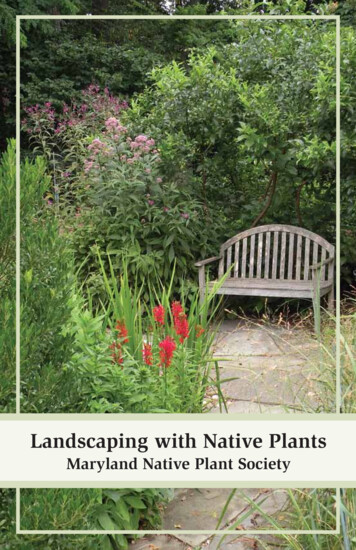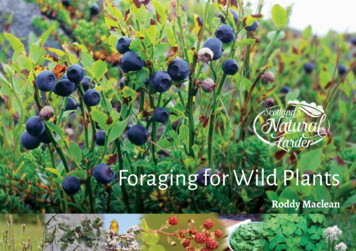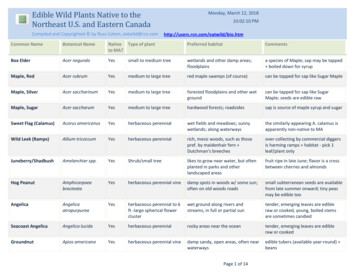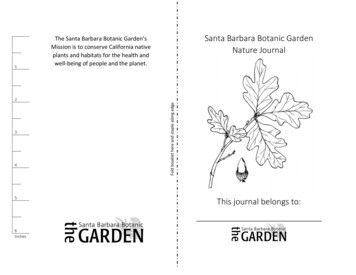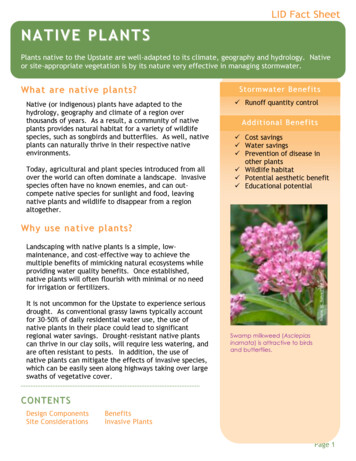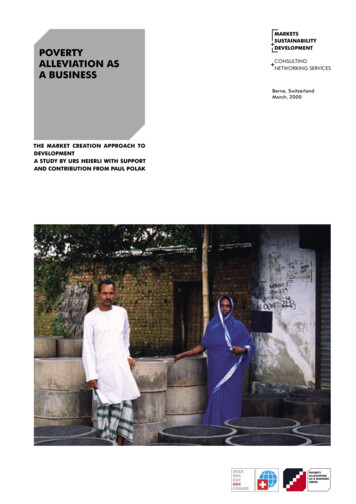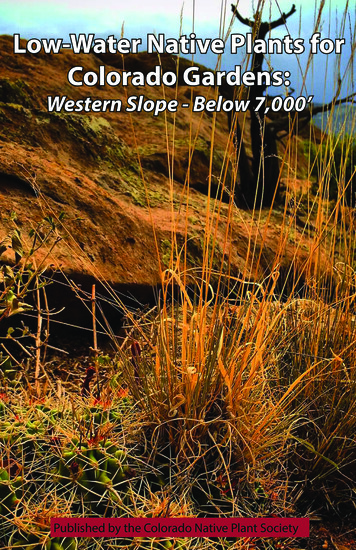
Transcription
Low-Water Native Plants forColorado Gardens:Western Slope - Below 7,000’Published by the Colorado Native Plant Society1
Western Slope Lower Elevation RegionXeric Garden (rabbitbrush, blue stem ephedra, yarrow, yucca) in Grand JunctionPhoto by Susan CarterThis range map is approximate. Please be familiar with your area to know whichbooklet is most appropriate for your landscape.The Colorado native plant gardening guides cover these 5 regions:Plains/PrairieFront Range/FoothillsSoutheastern ColoradoMountains above 7,500 feetLower Elevation Western SlopeThis publication was written by the Colorado Native Plant Society GardeningGuide Committee: Irene Shonle, Director, CSU Extension, Gilpin County; NickDaniel, Horticulturist, Denver Botanic Gardens; Deryn Davidson, HorticultureAgent, CSU Extension, Boulder County; Susan Crick, Front Range Chapter,Wild Ones; Jim Tolstrup, Executive Director, High Plains Environmental Center(HPEC); Jan Loechell Turner, Colorado Native Plant Society (CoNPS); AmyYarger, Director of Horticulture, Butterfly Pavilion. Scientific names are fromthe Flora of North America.Photo credits: Gardening Guide Committee members, David Winger, KentonSeth or otherwise listed.Map: U.S. Census Bureau, Census 20002IntroductionThis is one in a series of regional native planting guides that are acollaboration of the Colorado Native Plant Society, CSU Extension,Front Range Wild Ones, the High Plains Environmental Center, ButterflyPavilion and the Denver Botanic Gardens.Many people have an interest in landscaping with native plants,and the purpose of this booklet is to help people make the mostsuccessful choices. We have divided the state into 5 different regionsthat reflect different growing conditions and life zones. These are: theplains/prairie, Southeastern Colorado, the Front Range/foothills, themountains above 7,500’, and lower elevation Western Slope. Find thearea that most closely resembles your proposed garden site for thebest gardening recommendations.Why Native?There are many benefits to using Colorado native plants for homeand commercial landscapes. They are naturally adapted to Colorado’sclimates, soils and environmental conditions. This means that bychoosing native plants gardeners can work with nature, rather thantrying to grow plants that are not suited to our local conditions andmay prove to be difficult to work with.3
When correctly sited, natives make ideal plants for a sustainablelandscape. Native species require less external inputs such as waterand fertilizer, and are more resistant to pests and disease when theplanting site mimics the plant’s native habitat. Landscape water useaccounts for about 55 percent of the residential water used across thestate of Colorado, most of which is used on turf. Planting less-thirstynatives could lessen the burden on our water systems.Another great reason to go native is to restore habitat. Rapidurbanization in the state is reducing biodiversity (the number ofdifferent species found in a given area) as habitat is removed forbuilding and road construction. Research has shown that landscapingwith natives on a large or small scale, helps maintain biodiversity thatotherwise would be lost to development. Thousands or millions ofgardens planted with natives, even in urban areas can provide food,shelter and other important resources for wildlife, including mammals,birds and native pollinators.with its surroundings than a landscape transplanted from anotherlocale.Native Plant Gardening on the Western SlopeGardening on Colorado’s Western Slope below 7,000 feet can presentmany unique challenges. The area from Grand Junction to Durango isclassified as semi-desert shrubland and can be characterized as havingextremely low humidity and alkaline soils with poor water infiltration.Summer temperatures can be blazing during the day with coolernights and precipitation is low.Growing native plants does not exclude using adapted non-nativeplants. There are many non-native plants that are adapted toColorado’s climate and can be used in a native landscape as long asmoisture, light and soil requirements are similar. Even if a site hasa non-native landscape that requires additional inputs (such as anirrigated landscape on the plains), dry-land native plants can be usedin non-irrigated pockets within the non-native landscape. Thesenative “pocket gardens” can be located in areas such as median stripsand next to hardscapes that are difficult to irrigate. Note that in yearswith less than normal rainfall, non-irrigated landscapes may suffer inappearance without supplemental water.Gardening with native plants also prevents the introduction andspread of noxious weeds. Many noxious weeds were intentionallyintroduced as garden plants that belatedly were found to escape theconfines of the garden and crowd out native plants.Some communities regulate landscape appearance or the type ofplants which may be used. Before initiating any new landscape design,check with local municipalities and/or homeowners’ associations todiscover any regulations that may affect your design.Ute Ethnobotanical Garden, CSU Extension Office, Grand JunctionPhoto by Susan CarterFor this region, it is very important to choose plants that are nativeto the area and are already adapted to the soils and climacticconditions in order to save water and keep your garden lookinghealthy. Choosing plants that are native, and can thrive on littleto no supplemental water will lead to the greatest successes whengardening on Colorado’s Western Slope below 7000 feet.Finally, using native plants in landscapes helps provide a special senseof place, celebrating Colorado’s uniqueness and beauty, rather than ageneric landscape. A garden with native plants feels more harmonious45
Culture and MaintenanceSoilsColorado soils, on average, are fairly low in organic matter and highin pH (alkaline). The good news is that native plants usually can besuccessfully grown in unamended soils. This is because natives do notrequire nutrient rich, high organic content soil, and can often becomeovergrown or short lived in such soils. Many native plants, especiallythose from prairies or the Front Range, will thrive in clay soils. However,some native plants require well-drained soils. To amend clay soils,add 10 percent compost and 15 percent small aggregate (i.e., peagravel) by volume to clay/clay loam and incorporate into the root zone.Creating a small berm and planting on the top can also be helpful toimprove drainage. To amend excessively well-drained sandy or rockysoils, add 3 percent compost by volume. It may be beneficial to test thesoil before planting, especially on a larger project. Soil testing kits areavailable at your local CSU Extension office.MaintenanceNative plants often do not need much maintenance; just the usualpruning of dead or diseased material, and cutting back perennials inthe spring. Leaving seed heads on the plants in the fall will not onlyprovide a feast for birds, and protect caterpillar eggs and chrysalises,but will increase plant hardiness and winter interest. Native plantstypically do not require fertilizer. Some tasks, such as weeding anddeadheading, require the same time investment for native plantgardens as for gardens with non-natives.WateringPlants will need to be watered for at least the first season, with themost critical time being the first three weeks after planting. Once theyare established, water can be cut back gradually. After establishment,some natives can be taken off irrigation completely.resource intensive, provide habitat and provide more interest andcolor. Consider either limiting grass lawns to play, pet, or entertainingareas, or replacing lawns altogether if these spaces are not needed.To reclaim a space formerly devoted to a lawn, spend some timeeradicating all grasses and weeds. Grass is easier to kill when it is greenand actively growing in the spring or fall. There are a few options forthis. One is to use a glyphosate-based herbicide, another is to cut outall the sod, and a third is to solarize the area. Solarization works best inthe heat of the summer in full-sun areas.Mow the area and remove theclippings, water, place clearplastic on top (burying theedges with soil) and leave itfor 4-6 weeks. A final option isto sheet mulch. Cover the areawith sheets of cardboard or 12layers of newspapers. Overlapthese materials at least 6 inchesso no light penetrates and wetThis lawn is being smothered by layers ofthem down to keep them innewspapers covered with several inches ofmulch (created from a dead tree that wasplace. Place 1 inch of compostground up). Photo by Jan Turneron top of the barrier layer. Addat least 6 inches more of mulchor compost (grass clippings, straw or leaves). As these materials breakdown, they will create a rich humus layer while keeping weeds down.Allow at least 4-6 weeks.Wildlife & PollinatorsProviding habitat for songbirdsand pollinators is one of thegreat pleasures of gardeningwith native plants. To maximizehabitat for pollinators, plant adiversity of plants, and aim toprovide the longest possibleseason of bloom.Place plants that have higher water needs nearer the house or otherhighly used areas. These plants can also be planted in swales (lowerareas), or near downspouts for passive water harvesting.Limiting/reclaiming turf areasAlthough grass lawns are popular, they generally use more resourceslike water, fertilizers, pesticides, and maintenance (mowing) thana landscape of native plants. Lawns also provide no habitat forpollinators and birds. Native landscapes, on the other hand, are less6Butterfly on Rocky Mountain bee plant(Cleome serrulata). Photo by Jan Turner.Many plants will provide nectarfor adult insects, but consider7
the larval stage in planting too. Most native insects have specializedrelationships with native plants, and require specific plants to growfrom egg to adult. As an example, many butterflies will sip nectar fromnon-natives, but the eggs need to be laid on specific plants or thecaterpillars won’t recognize the plant as food. Purchase pesticide-freeplants. There has been recent concern that neonicotinoids are harmfulto bees, so look for neonic-free plants.Birds use native plants for food and shelter, but insects are anoverlooked and crucial part of many bird’s diets. Far more insects willdevelop on native plants than exotics, providing food for birds duringthe critical nesting season. Consider planting a ‘thicket’ of berryproducing shrubs. If planted in the direction of the prevailing wind,this thicket can also provide a space of calm air for butterflies.InventoryYour Yard &Microclimatesnaturalistic plantings that most people think of when they think native.Choose species based on the soil, light and water conditions of yoursite and for the size, shape, texture, and color desired. For a morenatural, successful and easily maintained landscape, group speciesthat grow together naturally and have the same cultural requirements.This will improve plant health and appearance and will minimizemaintenance.South-facing areas with reflected heat, will do best with dryland ordesert plants. North-facing areas are cooler, moister and shadier, andwill do better with forest-edge type plants. West-facing areas are moresimilar to south-facing, even if they only get a half day of sun, so thisis a good spot for dryland, prairie, or chaparral plants. The east-facingside is usually the most benign, and can grow a wide variety of plants.Plants that have higher water needs should be placed near the housefor easier watering, or near downspouts or in low-lying areas wherethey will get extra water.For the best garden,spend some time in theplanning stage. Identifywhere you would liketo create a new bed,or replant an existingone. Inventory theareas in your yard forsun and shade, and forClaret Cup Cactusareas where moisturePhoto by Susan Carteraccumulates. Considerwhat areas have easiest access from the house, and if there are viewsyou would like to enhance or block. All of these factors create what areknown as microclimates or small, but potentially significant changes inthe immediate environment that will affect your plants. Knowing theseahead of time will help you make the most of your site and can guideyour plant choices.Design for Low MaintenanceNative plants can be used to accomplish just about any design styleyou’re looking for using the elements and principles of good design:color, texture, balance, unity, variety, rhythm, line, form, scale. Theycan be used for anything from formal designs to the more informal8Fremont Barberry, Mahonia fremontii Photo by Susan CarterBe sure to be vigilant for weeds, especially in the first few years ofplanting, so they don’t take over the desirable vegetation. Plant thicklyenough that the plants become a living mulch.9
Suggested ReadingBusco*, Janice and Nancy Morin. 2010. Native Plants for High ElevationWestern Gardens. Fulcrum Publishing.Dorn*, Robert and Jane Dorn. 2007. Growing Native Plants of the RockyMountain Area. Lulu (available from CoNPS Bookstore as a book and CD).Elliefson, Connie and David Winger. 2013. Xeriscape Colorado. Westcliffe Pub.“Gardening with Native Plants.” 2016. Colorado Native Plant Society. es*, Rhona Fleming. 2015. Pollinator Friendly Gardening: Gardening for Bees,Butterflies and Other Pollinators. Voyageur Press.Nold, Robert. 2008. High and Dry: Gardening with Cold-Hardy Dryland Plants.Timber Press.“Plant Materials for Pollinators and Other Beneficial Insects in Eastern Utahand Western Colorado.” /COPMTN 75 130711 comp.pdfTallamy*, Douglas. 2009. Bringing Nature Home. Timber Press.Xerces Society*. 2011. Attracting Native Pollinators. Storey*Items available from the CoNPS Store at the time this booklet was published aremarked with an asterisk. Others may be out-of-print and can be obtained fromAmazon or the public library.Plant ListThe plants for each of these guides were selected by experiencedgardeners, with further input from members of the Colorado NativePlant Society. We aimed to choose plants that would be relatively easyto find in nurseries and seed catalogs. The scientific names are fromJennifer Ackerfield’s Flora of Colorado (Britt Press, 2015); synonyms arein parentheses. For a listing of nurseries and seed companies that carrynative plants, look for the “Native Plant Vendors” list on the ColoradoNative Plant Society (CoNPS) website at http://conps.org/gardeningwith-native-plants/ or consider attending the native plant sales held byCoNPS. When you go to a nursery, be sure to have the scientific namewith you to make sure you are purchasing the correct species. Don’tforget to ask for pesticide-free plants so pollinators won’t be harmed.10Colorado Native Plant Society Mission StatementThe Colorado Native Plant Society is dedicated to furthering theknowledge, appreciation and conservation of native plants andhabitats of Colorado through education, stewardship and advocacy.Visit CoNPS website at http://www.conps.orgKey to ChartThe chart on the following pages contains a list of plants, listedalphabetically by scientific name (column 2 of the chart), that are nativeto Colorado and do well in low-elevation western slope gardens. Thescientific names are from Flora of Colorado by Jennifer Ackerfield.Not all plants illustrated in this guide are listed in the chart, but thescientific names are given so you can find them in a nursery. If youhave questions, contact CoNPS or one of the other organizations thatcollaborated to produce this guide.frt/birds,wl fruit for birds and wildlifehp host plant-namen/hb nectar for hummingbirdsn/hm nectar for hawkmothnp/bee,btf nectar and pollen for bees and butterfliesnp/bee,btf,o nectar and pollen for bees, butterflies, and other pollinatorsp/bees pollen for beess/birds seeds for birdssh/birds shelter for birdsssh/birds seeds and shelter for birdsBloom Time:spring SPsummer Sfall F11
Common NameScientific dlife ValueGROUNDCOVERSKinnikinnickArctostaphylos uva-ursi1’ x 2’lowsun/part shadepinkSP-Sfrt/birds, wlSmall Leaf PussytoesAntennaria parvifolia2” x 6”lowsun/part shadepink to buffSP-Snp/bee, btf, oTrailing Fleabane/DaisyErigeron flagellaris6” x 12”lowsunwhiteSnp/bee, btf, oSulfur Buckwheat/FlowerEriogonum umbellatumvar. umbellatum10” x 12”lowsun/part shadeyellowSnp/bee, btf; hp-BluesMat PenstemonPenstemon caespitosus12” x 24”lowsunlavenderSP-Snp/bee, btf, hbJones’ BluestarAmsonia jonesii18” x 18”lowsunblueSP-Snp/bee, btf, oButterfly MilkweedAsclepias tuberosa L.18” x 18”lowsunorangeSnp/bee, btf; hp-Monarch larvaeLavender Leaf SundropsCalylophus lavandulifolius12” x 12”lowsunyellowSnp/beeClaret Cup CactusEchinocereus triglochidiatus6” x 12”lowsunredSP-Snp/bee, hbBlanketflowerGaillardia aristata12” x 12”mediumsunred & yellowS-Fnp/bee, btfBroom SnakeweedGutierrezia sarothrae18” x 18”lowsun/part shadeyellowFnp/bee, btf, oBlue Flax / Lewis FlaxLinum lewisii18” x 12”lowsun/part shadeblueSP-Snp/bee, btf, oColorado Four O’ClockMirabilis multiflora12” x 30”lowsun/part shademagentaSn/hb, hmBee Balm / Wild BergamontMonarda fistulosa L. menthafolia24” x 24”low/medsun/part shadepink tolavenderSnp/bee, btf, hbFirecracker PenstemonPenstemon eatonii12” x 24”lowsun/part shaderedSnp/bee, btf, hbPrairie ConeflowerRatibida columnifera24” x 18”lowsunyellowS-Fnp/bee, btf, oScarlet GlobemallowSphaeralcea coccinea8” x 12”lowsunorangeS-Fnp/bee, btf, o; hp-Small CheckeredSkipper larvaeDesert Prince’s PlumeStanleya pinnata36” x 18”lowsunyellowS-Fn/btfAchnatherum (Oryzopsis) hymenoides 24” x 12”lowsunsage-greenfoliage; tan inwinterSPERENNIALSGRASSESIndian Ricegrass12s/birds; hp-Skipper larvae13
Common NameScientific e GramaBoutleloua gracilis14” x 12”lowsunbluish-greenfoliageS-FLittle BluestemSchizachyrium scoparium24” x 18”lowsunbluish foliagein spring/summer,reddish inwinterSWildlife ValueGRASSESs/birds; hp-Skipper larvaeSHRUBSUtah ServiceberryAmelanchier utahensis12’ x 6’mediumpart shadewhiteSPfrt/birds, wlPanchito ManzanitaArctostaphylos x coloradoensis‘Panchito’6’ x 4’low-medsunwhite to pinkSPnp/beeMormom TeaEphedera viridis3’ x 4’lowsunyellowSRabbitbrushEricameria nauseosa ssp. nauseosa(Chrysothamnus nauseosus var.nauseosus)5’ x 5’lowsunyellowS-FApache PlumeFallugia paradoxa5’ x 5’lowsunwhite to pinkSDesert Prickly PearOpuntia SNarrowleaf Yucca / SpanishBayonetteYucca harrimaniae3’ x 1’lowsunwhiteSf/wl; hp-Yucca Moth larvaeinconspicuousSPhp-Swallowtail larvaenp/bee, btf, o; hp-Checkerspotlarvaenp/beenp/bee; frt/birds, wlTREESBigtooth MapleAcer grandidentatum30’ x 15’low-medsunSingleleaf AshFraxinus anomala12’ x 6’low-medsunUtah JuniperJuniperus osteosperma20’ x 10’lowsuninconspicuousss/birdsPinon PinePinus edulis25' x 12’lowsuninconspicuouss/birds, wlGambel’s OakQuercus gambelii25’ x 12’lowsun/part shadeinconspicuouss/birds, wl; hp-Purple Hairstreaklarvae1415
Landscape Design #1This garden is designed for a hot, Southern exposure and is loaded with texture. Littleto no water will be required after good establishment of all the plants. Hot dry gardenssuch as this benefit from clear space around the plantings to help make each form andflower stand out. This design provides color, texture, and year-round interest. The winterinterest provided by plants such as Arctostaphylos patula, Ephedra viridis, and Yuccaharrimaniae is hard to beat. Pea gravel mulch is recommended.Garden Design by Nick Daniel1. Mormon TeaEphedra viridis2. Little BluestemSchizachyrium scoparium13. Desert Prince’s PlumeStanleya pinnataYucca harrimaniae3324. Narrowleaf Yucca25. Panchito ManzanitaArctostaphylos x coloradoensis‘Panchito’6. Claret Cup CactusEchinocereus triglochidi5476980’5’Numbers on designcorrespond to plants listed7. BlanketflowerGaillardia aristata8. Lavender Leaf SundropCalylophus lavandulifolius9. CO Four O’ClockMirabilis multiflora1617
Landscape Design #2This hot dry, corner garden will be packed with color from Spring through Fall. Allplants included in this design appeal to pollinators and wildlife. The fiery red-orangecolor of the Bigtooth Maple in Fall when combined with the golden yellow of therabbitbrush, and ember red of the little bluestem, and the bright yellow leaves of thesingle leaf ash will stun! This garden is designed to be very low maintenance, and verylow water after establishment. Garden Design by Nick Daniel1. Bigtooth MapleAcer grandidentatum2. RabbitbrushEricameria nauseosaSchizachyrium scoparium4. Single Leaf AshFraxinus anomala5. Blue GramaBouteloua gracilis6. Jones’ BluestarAmsonia jonesii7. Butterfly MilkweedAsclepias tuberosa8. CO Four O’ClockMirabilis multiflora9. Mat PenstemonPenstemon caespitosus10. Apache PlumeFallugia paradoxa11. Claret Cup CactusEchinocereus triglochidiatus12. Desert Prickly PearOpuntia phaecantha3. Little Bluestem2143586722910311512130’145’Numbers on designcorrespond to plants listed13. Utah JuniperJuniperus osteosperma1814. Sulfur BuckwheatEriogonum umbellatum19
Published by the Colorado Native Plant Society, P.O. Box 200, Fort Collins, CO 80522www.conps.orgContributing Partners Include: Colorado Native Plant Society, Butterfly Pavilion,CSU Extension Native Plant Master Program, Denver Botanic Gardens, High PlainsEnvironmental Center, Front Range Chapter of Wild Ones201720
require nutrient rich, high organic content soil, and can often become overgrown or short lived in such soils. Many native plants, especially those from prairies or the Front Range, will thrive in clay soils. However, some native plants require well-drained soils. To amend clay soils, add 10 percent compost and 15 percent small aggregate (i.e., pea
